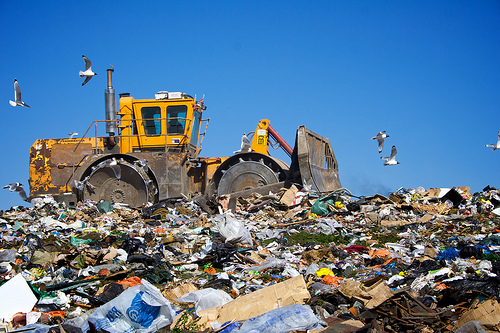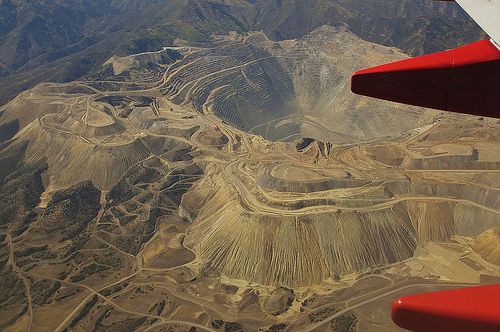3D printing vs Mass Production: Part IV More beautiful landfill
This is a part of a series of posts on 3D printing versus Mass Production.The other parts are: The Power of Unique, Manufacturing Complexity and Marketing Promise, Everything you own Sucks and Wish Fulfillment.
IV. More Beautiful Landfill
Mass Production will bring us a world where our landfill is ever more beautiful. We will just keep throwing away prettier, newer & more complex things at ever accelerating rates. We will in fact be hoovering the world’s resources into a self defeating search for happiness through consumption. As marketing and disposable income spread around the world many more people will want and be able to buy mass manufactured goods. The current negative impact on our environment is already noticeable but is only being created by a small segment of the world”s population.
If we look at OECD statistics we can see the Domestic Material Consumption of the OECD countries (under Environment Material Resources). This is the sum total of all materials extracted and used in an economy from biomass and metals to construction materials. It excludes all exports. Per capita material consumption for the OECD countries is 17.9 tonnes. In 22 of the richest countries in the world 17.9 tonnes of stuff each year is used. Per person. Per year. Portugal, a country that saw great economic gains over the period 1980 to 2005 (the period the study covers) saw its per capita Domestic Material Consumption increase 118% over the period. Similar growth in developing nations would put an inordinate burden on our planet.
But, even without such increases the path mass production is on is clearly unsustainable. The OECD has 1.1 billion citizens and for every one turns 17,900 kilos of this earth into things each year. A passenger car such as the Toyota Corolla weighs 1270 kilo. Per person we use up 14 passenger cars worth of material per year. The earth has a surface area of 510,000,000 square kilometers. Each year 14 billion Toyota Corolla”s worth of material is used. That comes out to 27 Toyotas worth of material for every square kilometer of the Earth’s surface per year. Every single square kilometer of the earth’s surface.
And that’s just the impact of the OECD countries, the rich people, that calculation does not include countries such as….China for example. It does not include the other 6 billion people on this planet. My fear is that eventually mass production could lead to mass extinction.
This scares me, scares me like nothing else does. I really believe we”re headed to the path to extinction. I’ve really, really, really tried to avoid coming to this conclusion but finally have to accept it. Like the Easter Islander”s we’re also going to cut down the last tree. Only we won’t turn it into a moai but rather some brushed aluminium gadget with a screen on it. You know, so we can look at pretty things.
3D printing will combat this but it would be foolish to try to compete head on with such an established destructive system. Rather, 3D printing should seek to “hoover up” all tho se consumers that seek to create better and more perfect products and give them an outlet in 3D printing. This will slow the growth of Mass Production by diminishing some of the time and attention given it. It will also cause 3D printing to bloom while in Mass Production’s shadow. The supreme irony of course is that it is precisely those most powering the unsustainable steam roller of Mass Production that will flock to 3D printing. Your neighbor, the one with the gold speaker cables, he has these giant beechwood sarcophagi in his living room. They’re speakers and cost $5000. It is this kind of person that finances the expansion of mass production into ever more complex goods. So with each new convert 3D printing wins an extra person while Mass Production loses one of its most strident adherents and financiers.
3D printing will in fact slowly deflate the bubble that is Mass Production. Not deflate it entirely, mind you. Just make it stop growing and shrivel a bit, like a day old party balloon.
But, wait a minute…
Is 3D printing even better for the environment? As a process 3D printing has several intrinsic advantages that make it more environmentally friendly than mass production. By producing close to the consumer less carbon is emitted. By using less material because it is an additive process we harm the earth less in creating things. By producing locally or in the home 3D printing could be coupled with a recyclebot that would offer closed loop recycling and cradle to cradle within the home. Tired of your plate? Toss it in the recyclebot and make a new one. Potentially fewer higher utility things could replace many mass produced ones.
But, 3D printing’s greatest environmental benefits lie in the way that it simplifies manufacturing. A camera supply chain comprises of thousands of individually motivated suppliers in many countries and it would be complex and difficult for a company to, even if it wanted to, audit and reduce its impact on the environment. Spot markets and tiered distributors obscure how camera parts are made and what impact individual parts, processes and their raw materials have. In mass production previous investments in tooling, factories and processes will make less environmentally friendly production the norm for a long time regardless of technological advances. Locked into a low cost production paradigm mass production companies could also find themselves unwilling or unable to adopt newer greener technologies.
Compare this with a 3D printed part. This has one company making the central input: a 3D printing material. If a strong and useful biodegradable material would emerge for one 3D printing process it could in one fell swoop make anything made with this process environmentally friendly. Without a plethora of suppliers pressure could be brought to 3D printer manufacturers and material manufacturers to make more environmentally friendly materials. It would be easier for them to comply since their own material supply chains are relatively very short. In this way any gains in materials would translate into huge efficiency gains for the entire 3D printing market. Even if the 3D printer manufacturers would not play ball, people could hack their own 3D printers to take newer and more environmentally friendly materials. Several material innovations could in this way transform 3D printing into a green process and with it make everything made with 3D printing environmentally sustainable. I don’t think a comparable innovation could happen within mass production. Check back tomorrow for the final part
Creative Commons Attribution, D”Arcy Norman & BSFMan
Recommended Articles
No related posts.




